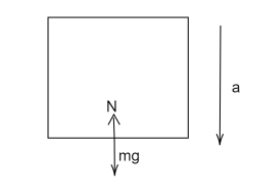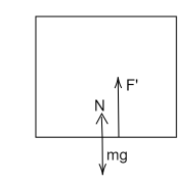
A man of mass $90kg $ is standing in an elevator whose cable broke suddenly. If the elevator falls, apparent weight of the man is-
(A) $90N $
(b) $90gN $
(c) $0N $
(d) Any negative value
Answer
220.5k+ views
Hint When the elevator is stationary, the weight of the man will be his mass times the gravitational acceleration. The weight is equal to the normal contact force which is experienced by the man on the floor of the elevator.
Complete Step by step answer
There are two ways to solve this question-
From an inertial frame of reference-
When the man and the elevator are observed from an inertial frame of reference, which is the ground. It can be observed that after the cable breaks, the lift starts to fall freely.
It is given that the mass of the man is, $m = 90kg $
Let the N be the normal reaction force, then it is given by,

$\vec N - m\vec g = m\vec a $
When the elevator is not moving, the acceleration, $a = 0 $
$N = 90 \times 10 $
Therefore force exerted by the man when the elevator is stationary the contact force (which is equal to the weight of the object), $N = 900N $
(taking, $g = 10m/{s^2} $)
When the elevator starts to fall freely, the acceleration becomes,
$a = g = 10m/{s^2} $
On balancing the forces,
$\vec N = m\vec g + m\vec a $
Since acceleration is downwards, it has a negative sign.
$N = mg - ma $
Substituting the value of $a $,
$N = mg - mg $
$N = 0 $
From non-inertial frame of reference
When the calculations are done from a non-inertial frame of reference, which is from inside the elevator. The acceleration of the frame of reference is also taken into account.
A pseudo force, equal to mass of the body times the acceleration of the frame acts in the direction opposite to the motion of the frame.
The free-body diagram looks like this-

Thus the normal force can be defined as-
$N + F' = mg $
$N = mg - F' $
We know that the pseudo force, $F' = mg $
Therefore,
$N = mg - mg $
$N = 0 $
Therefore the apparent weight of the object is zero.
Option (C) is correct.
Note
There are two types of frames of reference- inertial and non-inertial. The inertial frame of reference is either at rest or is moving with a constant velocity. Whereas a non-inertial frame of reference is accelerating. In a non-inertial frame, every object experiences a pseudo force which is in the direction opposite to the acceleration of the frame.
Complete Step by step answer
There are two ways to solve this question-
From an inertial frame of reference-
When the man and the elevator are observed from an inertial frame of reference, which is the ground. It can be observed that after the cable breaks, the lift starts to fall freely.
It is given that the mass of the man is, $m = 90kg $
Let the N be the normal reaction force, then it is given by,

$\vec N - m\vec g = m\vec a $
When the elevator is not moving, the acceleration, $a = 0 $
$N = 90 \times 10 $
Therefore force exerted by the man when the elevator is stationary the contact force (which is equal to the weight of the object), $N = 900N $
(taking, $g = 10m/{s^2} $)
When the elevator starts to fall freely, the acceleration becomes,
$a = g = 10m/{s^2} $
On balancing the forces,
$\vec N = m\vec g + m\vec a $
Since acceleration is downwards, it has a negative sign.
$N = mg - ma $
Substituting the value of $a $,
$N = mg - mg $
$N = 0 $
From non-inertial frame of reference
When the calculations are done from a non-inertial frame of reference, which is from inside the elevator. The acceleration of the frame of reference is also taken into account.
A pseudo force, equal to mass of the body times the acceleration of the frame acts in the direction opposite to the motion of the frame.
The free-body diagram looks like this-

Thus the normal force can be defined as-
$N + F' = mg $
$N = mg - F' $
We know that the pseudo force, $F' = mg $
Therefore,
$N = mg - mg $
$N = 0 $
Therefore the apparent weight of the object is zero.
Option (C) is correct.
Note
There are two types of frames of reference- inertial and non-inertial. The inertial frame of reference is either at rest or is moving with a constant velocity. Whereas a non-inertial frame of reference is accelerating. In a non-inertial frame, every object experiences a pseudo force which is in the direction opposite to the acceleration of the frame.
Recently Updated Pages
Mass vs Weight: Key Differences Explained for Students

Electricity and Magnetism Explained: Key Concepts & Applications

JEE Energetics Important Concepts and Tips for Exam Preparation

JEE Isolation, Preparation and Properties of Non-metals Important Concepts and Tips for Exam Preparation

JEE Main 2021 July 25 Shift 1 Question Paper with Answer Key

JEE Main 2021 July 22 Shift 2 Question Paper with Answer Key

Trending doubts
JEE Main 2026: Application Form Open, Exam Dates, Syllabus, Eligibility & Question Papers

Understanding Uniform Acceleration in Physics

Derivation of Equation of Trajectory Explained for Students

Hybridisation in Chemistry – Concept, Types & Applications

Understanding the Angle of Deviation in a Prism

How to Convert a Galvanometer into an Ammeter or Voltmeter

Other Pages
Thermodynamics Class 11 Physics Chapter 11 CBSE Notes - 2025-26

JEE Advanced Marks vs Ranks 2025: Understanding Category-wise Qualifying Marks and Previous Year Cut-offs

Units And Measurements Class 11 Physics Chapter 1 CBSE Notes - 2025-26

NCERT Solutions For Class 11 Physics Chapter 8 Mechanical Properties Of Solids

Motion in a Straight Line Class 11 Physics Chapter 2 CBSE Notes - 2025-26

Laws of Motion Class 11 Physics Chapter 4 CBSE Notes - 2025-26




